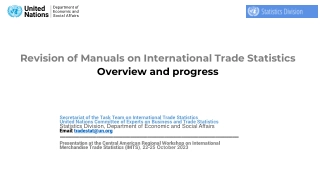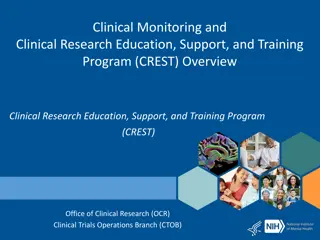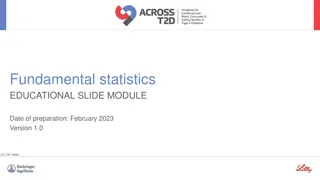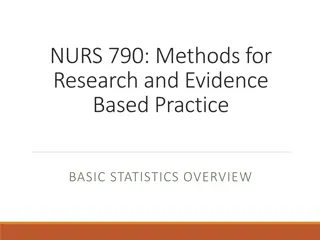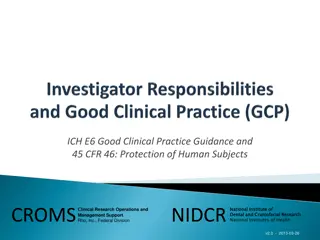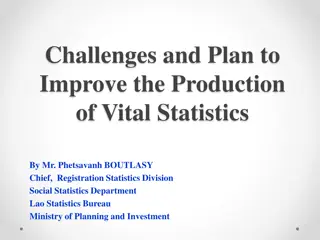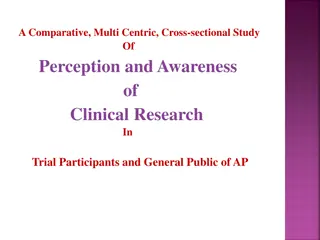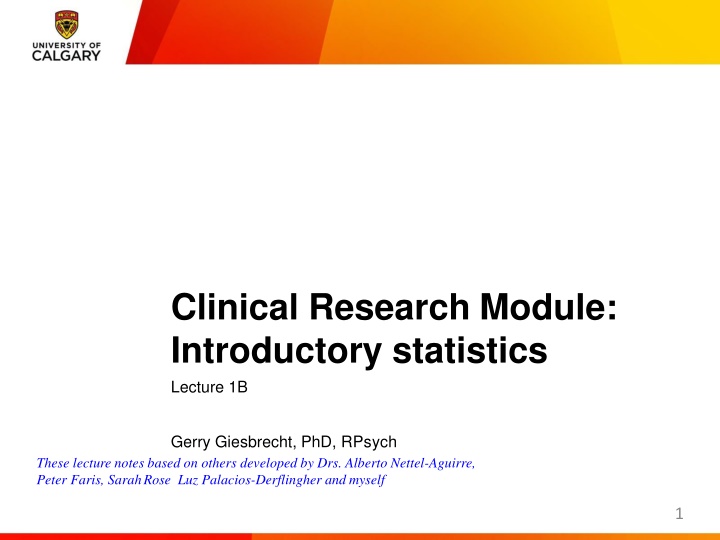
Introduction to Statistics in Clinical Research
These lecture notes cover the essentials of statistics in clinical research, including inference, sampling distributions, confidence intervals, hypothesis testing, and the importance of statistical analysis in separating signal from noise. Discover why statistics are crucial despite their reliance on assumptions and approximations.
Download Presentation

Please find below an Image/Link to download the presentation.
The content on the website is provided AS IS for your information and personal use only. It may not be sold, licensed, or shared on other websites without obtaining consent from the author. If you encounter any issues during the download, it is possible that the publisher has removed the file from their server.
You are allowed to download the files provided on this website for personal or commercial use, subject to the condition that they are used lawfully. All files are the property of their respective owners.
The content on the website is provided AS IS for your information and personal use only. It may not be sold, licensed, or shared on other websites without obtaining consent from the author.
E N D
Presentation Transcript
Clinical Research Module: Introductory statistics Lecture 1B Gerry Giesbrecht, PhD, RPsych These lecture notes based on others developed by Drs. Alberto Nettel-Aguirre, Peter Faris, SarahRose Luz Palacios-Derflingher and myself 1
Material Covered in this Lecture Lecture 1B- Inference The logic and use of statistics Sampling Distributions The normal distribution Confidence intervals Estimation and Hypothesis testing Difference of Means Power and Sample Size 2
Lies, damn lies, and statistics Statistics rely on assumptions and only provide approximate truths about the things that we really want to know about. And that doesn t even get into the quality of your data, their representativeness 3
So why bother? Because the alternatives are worse. Because clinical wisdom/intuition is susceptible to chance and confirmation bias. Because if we let the data speak, we will make new discoveries. Because statistics help to separate the signal from the noise. 4
Example 5
Example 6
Statistics make knowledge feasible Most of what we want to know, is (practically) unknowable. E.g., what proportion of people who smoke for at least 2 years die of lung cancer? Obtaining a sample of smokers and calculating the portion who die of lung cancer is feasible. 7
Example Results Int J Pediatr Endocrinol 2011 Nov8;2011(1):15. No significant differences were seen in the mean HbA1c between control and intervention at 0 months [8.48(0.86)vs 8.57(1.13)], F(1, 209) = 1.67, p = 0.43 . J Bone Joint SurgAm. 2012 Oct17;94(20):1853-60. at six weeks, the children who were allowed to bear weight as tolerated had better overall scores (95% CI = 2.34, 4.33) and better standing skills (95% CI = 7.29, 8.89) than those who were initially instructed to be non-weight- bearing Jacob Cohen: The earth is round p < .05. 8
The bottom line The two most important things to understand from the first part of this lecture: What is the best estimate for an effect (i.e., the point estimate) How much error is in the estimate (i.e., the confidence interval) 9
Material Covered in the Biostatistics Lectures Lecture 1B- Inference The logic and use of statistics Sampling Distributions The normal distribution Confidence intervals Estimation and Hypothesis testing Difference of Means Power and Sample Size 10
Theoretical concepts This might get a bit theoretical To understand statistics, we need to understand how the data we collect and the numbers we generate using statistics help us make sense of what is going on. This requires some theory and theoretical concepts. 11
Sampling Distributions For any estimate, the sampling distribution is the distribution of that estimate calculated for all possible samples of size n drawn from a population. 12
Sampling Distributions (example) For any estimate, the sampling distribution is the distribution of that estimate calculated for all possible samples of size n drawn from a population. 176 cm N = 100 Adult Males 230 cm N = 100 114 cm N = 100 176 cm N = 100 13
Sampling Distributions (example) For any estimate, the sampling distribution is the distribution of that estimate calculated for all possible samples of size n drawn from a population. Your study 176 cm N = 100 Adult Males 230 cm N = 100 114 cm N = 100 176 cm N = 100 14
Sampling Distributions Sampling distributions can be used to make inferences about the true parameter of a population 15
Sampling Distributions If you repeatedly take samples from a population, you will get a variety of different means, but some will be repeated. 176 cm N = 100 Adult Males 230 cm N = 100 114 cm N = 100 176 cm 16 N = 100
Sampling Distributions If we repeatedly calculate the mean of randomly drawn samples from a population, and then collect them all together, we get a sampling distribution, which we can use to estimate the population mean. 17
Sampling Distributions You might be wondering, how will we know where the mean we collected falls within the sampling distribution? 18
The sampling distribution is normal The normal distribution Central limit theorem: Means of random variables tend to be normally distributed. As the number of observations in sample approaches infinity, sampling distribution of the mean will approach the normal distribution. Great, but what does normal mean? 19
N = 1; = 22.3; SE = 21 3000Original data, =22.2 n= 5; = 22.3; SE = 9.6 2500 Frequency 2000 1000 500 0 0 0 50 100 150 200 0 20 40 60 80 X X n= 30; = 22.2; SE =4.7 n= 100; = 22.2; SE = 2 .1 1000 500 500 0 0 15 20 25 30 10 15 20 25 30 35 40 45 20 X X
Sampling Distributions Implication: Practical Application: So we know that we can pretty accurately estimate a population parameter using a sample, as long as the sample is big enough Larger sample sizes help you accurately estimate what is going on in the population. What is big enough ? In theory, about 30 should get you there, but in practice 100 is generally considered big enough. 21
Estimating Error We can calculate the variability within our sample by adding up the differences between the individual values and the sample mean. This is called the standard deviation. 22
Estimating Error We can also calculate the variability within our sampling distribution. That is, we calculate all the deviations of the sample means from the population mean. This is called the standard error. 23
Standard Error The standard error of the mean (SE) is the standard deviation of these sample means Sampling distributions can be used to make inferences about the true mean of a population 24
Inferences about the mean Usually standard deviation of population unknown Use SD of sample (S) as estimate of population s With sample S, estimate the SE as SE = SD / n As n increases SE decreases This means that if we use our sample mean as an estimate of the population mean, our estimate will be more accurate as our sample size increases 25
Confidence Intervals Given the normal sampling distribution of the means, 95% of sample means will fall within 1.96 standard errors of the sample mean. Because there is error in our estimate of the mean, we can use the normal distribution to create a confidence interval. 26
Confidence Intervals Example: A researcher reports a mean systolic blood pressure of 129 with a 95% confidence interval of [125 - 133]. What does this mean? Because of the properties of the normal distribution, we are confident that the true mean systolic blood pressure is between 125 and 133. In fact, there is only a 5% chance that our CI does not contain the true population mean. Confidence intervals give a sense of the precision of the estimate. Wide confidence intervals indicate a less precise estimate than narrow CIs. How did we obtain the CI? We used the SD of our sample to estimate the SE of the population. We multiplied the SE by 1.96 (95% interval) We added this error (= 4 in this case) to the mean.27
Confidence Intervals Example: A researcher reports a mean systolic blood pressure of 129 with a 95% confidence interval of [125 - 133]. What does this mean? How did we obtain the CI? We used the SD of our sample to estimate the SE of the population. SE = 20/ 100 = 2 We multiplied the SE by 1.96 (95% interval) 2*1.96 = ~4 We added this error to the mean. 129+4 = 133; 129-4=125 28
Material Covered in the Biostatistics Lectures Lecture 1B- Inference The logic and use of statistics Sampling Distributions The normal distribution Confidence intervals Estimation and Hypothesis testing Difference of Means Power and Sample Size 29
Hypothesis Testing: Difference in means Interested in comparisons between groups or associations among variables. Does the BP of 2 groups actually differ? Is folate really associated with neural tube defects? Humans vary in their response to treatments, exposures etc. How do we know that observed effects can be attributed to the treatment or grouping ? 30
Hypothesis Testing: Difference in means When comparing two measures of interest (e.g. means), we compare the observed difference in these to the distribution of differences we would expect to occur under the assumptions of null hypothesis. H0 : We refer to the hypothesis of no difference or no effect as the null hypothesis. HA : We specify an alternative hypothesis. 31
Example-Two independent groups Researchers want to compare the 24-hour total energy intake in two populations using two samples: lean and obese people Let L = mean energy intake for the population of lean people Let O= mean energy intake for the population of obese people H0: L = O HA: L O 32
Hypothesis tests Most of the tests we will see in this course will have the form of: test statistic =Observed hypothesized standard error of observed observed comes from sample, x, (sample mean), or differences of means between groups. Standard error of the observed will take different formulations but will still refer to variability in the estimation of the parameter of interest. 33
Hypothesis tests Most of the tests we will see in this course will have the form of: test statistic =Observed hypothesized standard error of observed hypothesized here we are going to do a little trick to make the problem tractable. By making the null our hypothesized result, it is by definition zero, and we can drop this part of the equation. Observed test statistic = standard error of observed 34
t-tests cont Because we don t know the population standard deviation (the standard error), we estimate the population standard deviation using data from the sample. 35
Example: 24h energy expenditure 24 hour total energy expenditure (MJ/day) in groups of lean and obesepeople (Prentice et al, 1986) Lean (n=13) Obese (n=9) 6.13 8.79 7.05 9.19 7.48 9.21 7.48 9.68 7.53 9.69 7.58 9.97 7.90 11.51 8.08 11.85 8.09 12.79 8.11 8.40 10.15 10.88 Mean 8.07 10.30 SD Data from Altman, 1995, Practical Statistics for Medical Research, Table 9.4, p. 193 1.24 1.40 36
Independent groups t-test H0: True mean of Lean ( L) = True mean of obese ( O ) HA: True mean of Lean ( L) True meanof obese ( O) =Observed difference Hypothesized difference t (nO +nL 2) Error Observed difference: 10.3 - 8.07 = 2.23 Hypothesized difference: 0 Standard Error = 0.5656 (pooled from the 2 samples) t = 2.23 0/0.5656 = = 3.94 Compare our obtained value of t to the critical value of t (the value of t associated with our alpha level (two-tailed)). 37
t-tests cont We can then use the t-distribution to make inferences about differences between our sample means. 38
Independent groups t-test (cont) Values above 2.086 are unlikely in the t distribution when there are 20 df. Conclusion: Reject the null hypothesis of no difference in energy expenditure. Instead, we believe there is evidence to suggest a difference in the 24-hour total energy expenditure between lean and obese people. There is less than 5% chance that we would have obtained this difference in energy expenditure if there were no differences between lean and obese people. 0.4 0.3 Rejection region Rejection region 0.2 0.0 2 2.086 -4 -2 0 4 -2.086 t-values 39 3.94
Confidence Limits Point estimates are great (simple) but you should always report the range of estimates that are plausible, given your data. This requires creating a confidence interval (CI). 95% CI = sample meanO sample meanL (t(critical)*SEdifference) For a 95% CI the critical value is 2.086 The mean difference between groups is 2.23 The SE of the difference is 0.5656 2.23 2.086*0.5656 95% CI is 1.05 to 3.41 40
Confidence Limits Interpretation: The likely range of the true difference in population can be as small as 1.05 or as big as 3.41. That is, that the mean for obese is at least 1.05 units larger and up to 3.41 units larger Relationship between statistical test at alpha level of 5% and 95% confidence interval A CI that includes 0 has a p-value > 0.05 41
Advice You aren t expected to know a lot of detail about statistical tests. Familiarize yourself with the basics of hypothesis testing this will be very helpful for your understanding of literature and a bit of effort will serve you well in the future. If you have a significant p value you reject the null, which means that there is reason to doubt that the true effect is zero. If you have a non-significant p value you fail to reject the null, which means that you cannot distinguish the effect from zero Report confidence intervals! 42
Material Covered in the Biostatistics Lectures Lecture 1B- Inference The logic and use of statistics Sampling Distributions The normal distribution Estimation and Hypothesis testing Confidence intervals Difference of Means Types of error Power and Sample Size 43
Statistical Power Statistical power (1-beta) is the probability of rejecting the null hypothesis when it is false in the population (i.e. it is the probability of correctly concluding there is evidence of a difference). Studies with small sample sizes may not have adequate power to detect clinically meaningful effects. These studies are sometimes referred to as being underpowered. What is the difference between clinical and statistical significance? 44
Sample Size/Power Calculations: Background: What are they and why do them? Typically we are interested in calculating a sample size for a study that is adequately powered . - Adequate is usually defined as at least 80%. 45
Sample Size Estimates: Inference Inference In research, can t measure everyone. Make inferences on true or underlying characteristics of a population on the basis of data collected from a sample. The more subjects measured, the more accurate our estimates will be. (bias?) Measure too many, waste resources. Measure too few, won t be able to detect effects of interest. But how many patients? 46
How Many Subjects? This depends on several things The kind of statistical tests to be used. Choice of study design. The variability of the values in the population. The alpha level (probability of concluding that there is an effect or difference, when in truth, there is no effect). The statistical power (the probability that we will conclude there is an effect, given that the true effect is of a given size). The magnitude of the hypothesized effect. (e.g. What is a clinically relevant difference in means?) The number of drop-outs or non-responders. 47
Hypothesis based estimates cont Power can only be specified for explicit alternative hypotheses e.g. HA: 1 = 90; 2 =110, or alternatively HA: 2 - 1 =20 For hypothesis-based sample size calculations, have to state the size of the treatment effect that we wish to be able to detect. This difference is usually taken to be one that has clinical relevance. (i.e. what is the smallest difference that would be considered clinically meaningful?). 48
Example: Comparing Means Researchers would like to do a clinical trial comparing methods of treating dorsal wrist pain. Treatments will be typical physiotherapy (control group) vs physiotherapy plus shock wave therapy (treatment group). They will use the PRWE, a validated measure with a maximum score of 100, to evaluate pain and function. Their outcome will be the change in the PRWE from the pre-treatment baseline score to the 6- month follow-up score. 49
What do we need for calculations? Variability of the outcome: Because they are studying change in PRWE, they need to know the variability of 6- month changes in the PRWE. From the medical literature and correspondence with the developer of the PRWE, they established that the range of the SD of thedifferences was between 17 and 22. Clinically relevant improvement: Based on other studies, the researchers propose that a clinically relevant difference in change would be 20 points. Alpha Level: 0.05 Power: 80% Dropout rates: They anticipate a 10% dropout rate in each group. Sample size calculators: http://www.cs.uiowa.edu/~rlenth/Power/ 50

